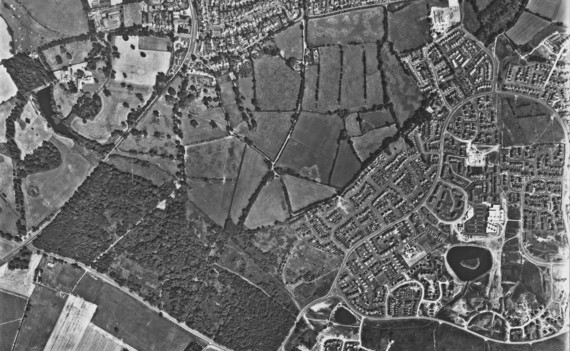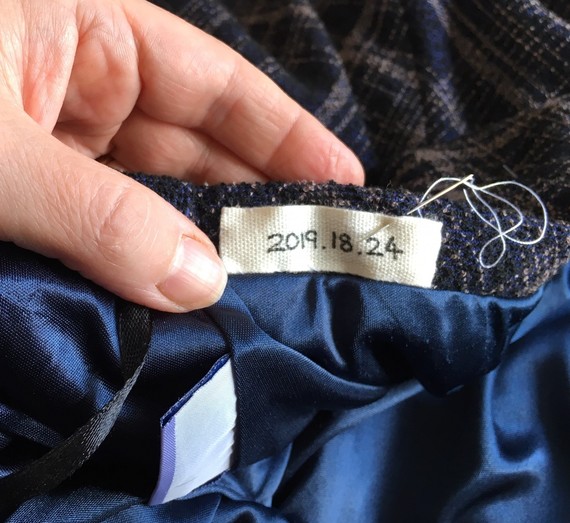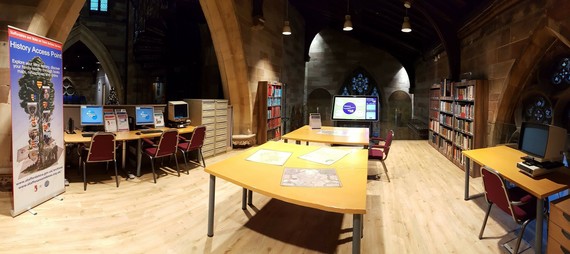 Early 19th century tea figure from Market Street, Stafford.
August saw the launch of the new exhibition "Distinctively Staffordshire" at the Staffordshire Record Office, Eastgate Street, Stafford.
The exhibition explores what makes Staffordshire such a distinctive and unique county using documents and objects from the Staffordshire and Stoke-on-Trent Archive Service, William Salt Library and Staffordshire County Museum Collection.
The exhibition features a 1930s pattern book from New Chelsea Pottery, an early 19th century Chinese tea figure and an illustration from Robert Plot's Natural History of Staffordshire, 1686. The exhibition is free and is open during SRO hours (see below).
 Pattern book from the New Chelsea Works, 1930s (SD4842/715)
FoSSA Visit to Ingestre Orangery
Wednesday 4 September 2019, 2pm
Ingestre Orangery is a Grade II listed building in the village of Ingestre. The Orangery sits in the grounds of Ingestre Hall and is owned by Sandwell Council. The Friends of Ingestre Orangery have a lease from Sandwell Council and are working to restore the Orangery so that its heritage can be shared, used and enjoyed using a Heritage Lottery Fund grant of £48,900. Restoration is well underway and events are now being held in the Orangery.
Ingestre Orangery was built in 1838, strongly influenced by James 'Athenian' Stuart's nearby orangery at Blithfield Hall (c.1770). The afternoon will include a visit to Ingestre Church which will be opened specially for us and there will be a break for refreshments. A speaker from the Trust will tell us about the challenges of the restoration project and plans for its future, and Dianne Barre will give a short talk about the house, gardens and park which are not open to the public. Includes tea and cake.
The Orangery opened officially at the beginning of June for group tours and we are amongst the first groups to visit. To book a place please contact richard.totty4@gmail.com Tickets are £8.00 for members, £9.50 for non-members
 Aerial view of Perton, August 1981. Image courtesy of Mr G. Khosa
Getting Down and Digital in Perton
Join us at Perton Library for our Digital Drop In Day on Saturday 5 October between 10am and 4pm. Members of the Staffordshire County Museum team will be on hand to scan your photographs of Perton and local area on to the Staffordshire Pasttrack website.
Perton Library is also hosting two sessions with poet Mal Dewhirst. Join us to share the stories and history of Perton though looking at documents and objects from the County's archive and museum collections. These 'Creative Conversations' will take place on Thursday 5 September (2-4pm) and Tuesday 8 October (10-12am).
Your Heritage … Your opportunity
The ‘Your heritage…’ project in the History Access Point at St Mary’s, Lichfield is an opportunity for you to create your own mini exhibition to share with visitors and local people. Interested individuals or groups can choose an object or document (or a series of objects/documents) to put on display which have links to Lichfield or a general community interest. Your display will also include information such as; why you chose the item, what it is and why it is meaningful to you?
We launched this project in June with a collection of historic Guides to Lichfield and information about the history of tourism in the city. The current mini exhibition shares a collection of Moon memorabilia, celebrating 50 years since the Apollo moon landing and runs alongside our Memories of the Moon Landing activity. Over the summer holiday period staff have collected memories and thoughts about the impact of this momentous event in our special Moon Lander post box. For more details keep an eye on social media.
Have you got something from your family or organisation that you would like to share with the community? If so, contact Staffordshire Record Office for further details.
 Marking a new accession with its unique number
Behind the Scenes at the Museum - Marking and Labelling
Every new item that is donated to the museum collection is given an accession number which links it to its donor and documentation. Once the record has been completed all items are marked with their unique number. This has to be done in such a way that the number is easy to find but not visible when the object is put on display. All marks have to be reversible so that they can be easily removed without damaging the item should the need arise.
With garments and textiles a piece of unbleached cotton tape is marked with the number and this is then sewn into the item. In skirts and trousers the tape is usually attached at the back inside the waistband (pictured). Jackets, shirts and blouses are generally marked inside the neck or shoulder seam. The trick is to make the tape secure while minimising the number of stitches being placed in the garment. A label is tied on to the garment or coat-hanger so that it can be easily found when needed.
 Lichfield St Mary’s History Access Point
Our History Access Point has been a new approach for the Archive and Heritage Service. In partnership with the Library we have worked hard to identify a range of resources that allow users to start their family and local history research.
Many of us talk about starting our family trees but never seem to find the time. What resources are available, what websites should we subscribe to, where do we start? If you need help we have a wide range of family history books which can help to explain how to go about your family history research and more specific pointers for targeted research. Here you can access both Ancestry and Find my Past free of charge and start your journey to finding out more about your own genealogy. If your family has roots in Staffordshire, you can track more recent ancestors through the microfiche copies of baptisms, marriages and burials or browse the Parish Register transcripts, which one visitor recently described as “invaluable”.
Do you remember special events in Lichfield that might have involved your family? You can browse the Mercury newspaper on microfiche right back to the 1800s and capture a glimpse of these events and of how life has evolved for the people of Lichfield over time. View photographs; gain perspective on how events have shaped people’s lives; and explore how times have changed.
Are you more interested in finding out more about the local area? We also have a wide range of books on local history research; Staffordshire; and Lichfield and the surrounding district. Explore the history of the Cathedral, find personal accounts about the changing shape of Lichfield or find out about Samuel Johnson and other local personalities.
Whatever your family or local history interests, try exploring the History Access Point. You never know what you might find out!
Calling all Archivists and Historians!
Alongside the 19th century Prisons Database which provides a searchable list of 847 prisons and their archives, Rosalind Crone has developed Your Local Lock-Up; a public engagement project which aims to locate any structures used for temporary imprisonment or restraint.
These lock-ups might have confined the accused until they appeared before a local magistrate, when being moved between penal institutions, or when undergoing trial. Some lock-ups, like stocks, could also have been used to punish those ‘behaving badly’ in the local community.
Lock-ups have been almost entirely overlooked by penal historians, but they are essential for understanding criminal justice at the local level, and the use and experience of imprisonment in British history. Your Local Lock-Up at www.prisonhistory.org/local-lock-up/ is building a national database of surviving or demolished lock-ups and other places of local confinement. This will allow us to explore various aspects of lock-ups’ use, character and design, and enable us to complete the next stage in the recovery of the penal landscape of historic Britain.
To do this, we now need the help of local historians and archivists! There are around 650 lock-ups in the database but currently only 13 for Staffordshire. This is far from exhaustive, and we anticipate that there are countless others we know nothing about. We are therefore calling upon archivists, historians and members of the public, to help us recover more lock-ups, or add information to the lock-up profiles we already have in the database.
If you happen to know of collections of material in your archive that relate to lock-ups - including police stations, cells in town halls, courthouses, workhouses, and stocks - used for temporary confinement between the 16th and the early 20th century, we would be so grateful if you could pass details on to us. We have developed a contribution form for new lock-ups at https://www.prisonhistory.org/local-lock-up/submit-lock-up/ and an ‘Anything to Add’ button for existing lock-ups, so that information can be put directly into the database. We are particularly keen to collect historic and present-day descriptions of lock-ups, images of lock-ups, and anecdotes about the use of lock-ups.
Finally, why not connect with Prison History UK on social media? You can follow Prison History UK on Twitter, ‘like’ our Facebook page and share material with us on Instagram. You can also subscribe directly to our mailing list at www.prisonhistory.org to receive the latest project news and updates.
If you have any queries, or would like further information about Your Local Lock-Up, please email Dr Rosalind Crone at Rosalind.Crone@open.ac.uk or Dr Elaine Saunders at earlypolicing@gmail.com
Staffordshire Record Office – New Opening Hours
The new opening hours at the Staffordshire Record Office have now taken effect.
• Tuesday: 10.00 – 4.00
• Wednesday: 10.00 – 4.00
• Thursday: 10.00 – 4.00
• Friday: 10.00 – 4.00
• Saturday: 9.00 – 1.00 (third Saturday in the month)
Our aim is to keep you updated with the latest developments and events. If you do not wish to receive this newsletter please use the 'unsubscribe' button at the bottom of this page.
|